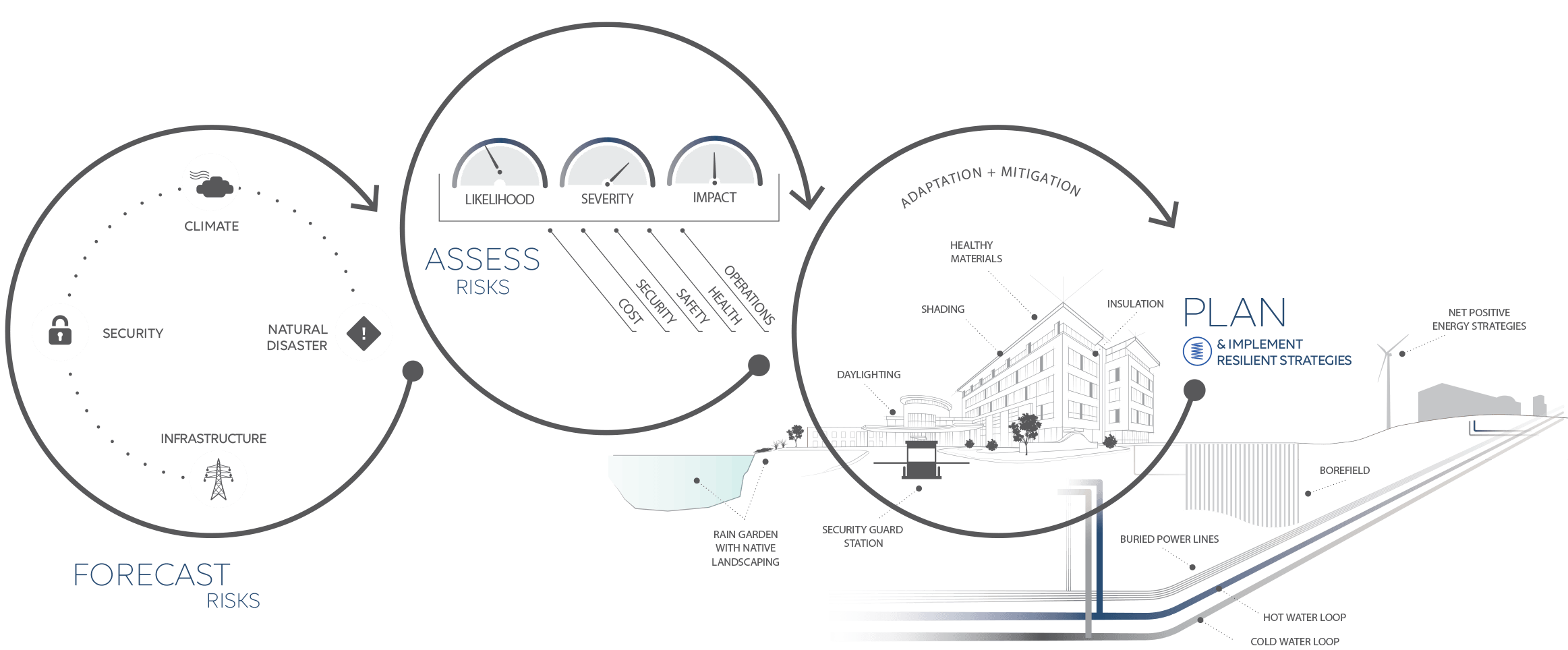The concept of resiliency, bouncing back quickly from disruptions, is not necessarily new—it has always has been part of strong facility planning. What is new is the growing awareness of external risks (climate change, security risk, infrastructure disruptions, and natural disaster) that have the potential to interfere with delivery of critical services.

Our role as designers is to work with building owners to forecast potential risks, assess the likelihood and impact of each risk, and plan for resilient strategies that will mitigate those risks.
There are certainly no easy answers. But by opening a dialogue with facility owners and colleagues by forecasting and assessing risks, we are exploring potential solutions to better prepare their organizations.
Forecast Risk
Planning for resiliency considers factors such as building type, business operations, and geographic location. Each building type—whether government, corporate, healthcare, or higher education—requires a targeted approach to forecasting risk. Government buildings needing high-security measures face challenges different from hospitals that must to be operational 24/7 to deliver life-critical services. Yet each benefit from a strategic process that evaluates potential internal and external risks.
The first step toward a resilient future is forecasting risks to the project site and building operations. Risks tend to fall into a few categories, including but not limited to natural disaster, climate, security, and infrastructure. Each risk category is not equal and one may outweigh the other depending on individual building program and location.
To forecast natural disasters, building owners must weigh the potential for floods, earthquakes, tornadoes, hurricanes or other natural phenomena disrupting operations. Climate, on the other hand, may pose potential risk from rising sea levels for one building owner, while more extreme weather events or temperature variations could pose risks for owners in a different location.
Similarly, forecasting security risks for a public building such as an airport could require heightened screening against acts of terror, while an office building may screen employee and visitor traffic to manage security, and an academic building may integrate strategies to monitor student safety.
Determining infrastructure risks will involve evaluating both the building systems and municipal utilities to establish how well the infrastructure is meeting capacity and whether there are any potential risks of the utility providers being unable to provide services.
Assess Risk
After forecasting risk, the next step is to assess the likelihood, severity, and impact of those risks. What is the likelihood of a risk becoming a reality, and what would the severity be? A ½-inch per hour rain event will be far less severe than a 3½-inch per hour rain event. What are the potential impacts, both short-term and long-term? How would those impacts affect operations, health, and safety of occupants or building security? What might the cost implications be? Are internal and external response mechanisms already in place for this risk?
Many facility owners already have emergency management plans in place, yet risk management is often approached incrementally rather than holistically. By systematically assessing risk, owners can evaluate all possible risks and determine which may have the greatest impact. For instance, one hospital on the Northeast Atlantic coast and another on the Southeast coast both risk being impacted by a category 3 or stronger hurricane, but the Northeast hospital has a lower likelihood on average. Yet as Hurricane Sandy destructively demonstrated in 2012, low likelihood can still translate into high impact if a hurricane does occur. In this example, hospital administrators may plan for a hurricane, even though likelihood is low, to continue to serve their patients should such a storm occur.
The goal of the assessing phase is to put information in building owners’ hands so they can make informed decisions about how to plan for risk.
Plan for Risk
Once building owners have forecast and assessed risks, they can prioritize where time and budget should be spent, implementing resilient strategies that will enable them to function during an adverse event and quickly resume normal operations. Planning does not eliminate risk, but rather anticipates and prepares for risks through adaptation and mitigation.
Planning considers several factors most relevant to a particular building type and location—from improved insulation and shading techniques that mitigate heat gains, to renewable energy sources that reduce reliance on the central grid, to a centrally located security guard station that increases employee safety.
A building near a floodplain, for instance, may consider a high-capacity storm-water retention basin and native plantings within the campus landscaping to mitigate the impact of increased flooding incidents. Similarly, buried power lines may reduce incidents of power failure during severe storms and high winds.
Through resilient planning, building owners can safeguard their investment, protect building occupants, and quickly adapt to changing circumstances.
